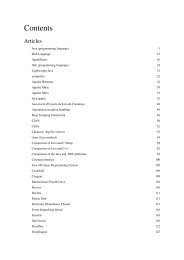Structured Query Language (SQL) - Cultural View of Technology
Structured Query Language (SQL) - Cultural View of Technology
Structured Query Language (SQL) - Cultural View of Technology
Create successful ePaper yourself
Turn your PDF publications into a flip-book with our unique Google optimized e-Paper software.
Check Constraint 19<br />
Check Constraint<br />
A check constraint (also known as table check constraint) is a condition that defines valid data when adding or<br />
updating an entry in a table <strong>of</strong> a relational database. A check constraint is applied to each row in the table. The<br />
constraint must be a predicate. It can refer to a single or multiple columns <strong>of</strong> the table. The result <strong>of</strong> the predicate can<br />
be either TRUE, FALSE, or UNKNOWN, depending on the presence <strong>of</strong> NULLs. If the predicate evaluates to<br />
UNKNOWN, then the constraint is not violated and the row can be inserted or updated in the table. This is contrary<br />
to predicates in WHERE clauses in SELECT or UPDATE statements.<br />
For example, in a table containing products, one could add a check constraint such that the price <strong>of</strong> a product and<br />
quantity <strong>of</strong> a product is a non-negative value:<br />
PRICE >= 0<br />
QUANTITY >= 0<br />
If these constraints were not in place, it would be possible to have a negative price (-$30) or quantity (-3 items).<br />
Check constraints are used to ensure the validity <strong>of</strong> data in a database and to provide data integrity. If they are used<br />
at the database level, applications that use the database will not be able to add invalid data or modify valid data so<br />
the data becomes invalid, even if the application itself accepts invalid data.<br />
Definition<br />
Each check constraint has to be defined in the CREATE TABLE or ALTER TABLE statement using the syntax:<br />
CREATE TABLE table_name (<br />
)<br />
...,<br />
CONSTRAINT constraint_name CHECK ( predicate ),<br />
...<br />
ALTER TABLE table_name<br />
ADD CONSTRAINT constraint_name CHECK ( predicate )<br />
If the check constraint refers to a single column only, it is possible to specify the constraint as part <strong>of</strong> the column<br />
definition.<br />
CREATE TABLE table_name (<br />
)<br />
...<br />
column_name type CHECK ( predicate ),<br />
...










